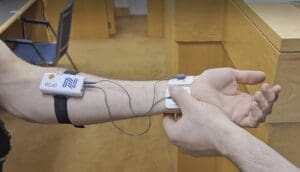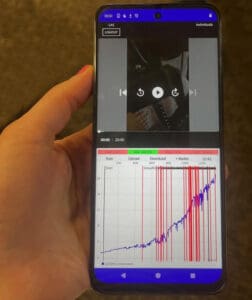Enhancing Scenario-Based Training with Real-Time Stress Monitoring
Published

Scenario-based training helps officers and military professionals make decisions under pressure, but performance in high-fidelity environments doesn’t always reflect what’s happening internally. That’s why the MILO Range, MILO Live, and MILO VR systems now integrate with Neurosmart, a wearable device that monitors stress through electrodermal activity (EDA), giving instructors a clearer picture of physiological readiness, regulation, and recovery.

What Neurosmart Measures
Neurosmart captures real-time EDA, a clear indicator of stress and cognitive load. This data is synced directly with scenario video, enabling instructors to see exactly when stress spikes—even if the trainee’s outward behavior hasn’t changed. This groundbreaking integration tracks four dimensions:
Anticipatory Anxiety – Pre-scenario activation. This can help determine how the officer or trainee is perceiving or preparing for a scenario before they’re in it.
Elevated stress before a scenario is common and often a healthy indicator that the officer is planning their actions. However sometimes it can indicate anxiety, perceived difficulty, uncertainty, or threat associated with an upcoming situation. In one study, researchers found measurable autonomic arousal even before calls began, during dispatch and en route phases, indicating that baseline stress can be elevated in anticipation of duty-level events.
Instructors spotting those signals may decide that modifying training is appropriate to include more instruction, more realistic content, provide extra time to work through the complexity, or customize the scenario to the participant’s level of expertise in that context.
![]()
Vigilance – Sustained attention during the scenario. This reflects how intensely the trainee remains physiologically engaged throughout the scenario. Not being vigilant enough can cause slow reaction times, missed threats, or may indicate the training is not inducing enough stress. While alertness is necessary, exaggerated or prolonged vigilance can indicate overactivation of the sympathetic nervous system, which may impair decision-making or lead to tunnel vision.
In 2024, researchers studying SWAT-trained officers in a VR-based mental health crisis scenario observed sustained physiological arousal—measured by EDA and heart rate—that aligned with continuous task engagement. The researchers described this as a “Defensive-Dynamics Dichotomy,” noting that the prolonged stress response could interfere with adaptive tactical behavior under pressure.
Instructors observing consistently high stress throughout a scenario may need to evaluate whether the scenario’s pacing or complexity is overwhelming the participant. If trainees demonstrate low vigilance, instructors may escalate scenario complexity or introduce unexpected elements to increase operational pressure and drive a more realistic stress response.
![]()
Stress Regulation – Ability to stabilize under pressure. This shows whether a trainee can manage physiological arousal during and immediately after peak stress. Proper regulation indicates effective threat appraisal and control. When stress remains elevated after the threat has passed, it may signal difficulty disengaging from perceived danger or an inability to self-soothe.
One research team observed that officers trained in slow, diaphragmatic breathing maintained significantly better heart rate variability during a high-pressure shoot/don’t-shoot simulation. Those who practiced breath control were better able to down-regulate in real time, even while making rapid decisions under stress. This highlights the value of embedding regulation tools into MILO scenario-based training.
Instructors can address instability through pacing adjustments or regulation strategies.
![]()
Recovery – How quickly stress levels return to baseline. This reflects how well the trainee’s nervous system disengages after the scenario ends. Fast recovery allows individuals to reset and maintain situational awareness across multiple engagements. When stress lingers after the threat is resolved, it may indicate that the body remains in a defensive state, increasing the risk of fatigue, reduced performance, or long-term wear on mental and physical health.
In a large-scale review of first responders and tactical operators, researchers found that individuals exposed to high-magnitude stressors often showed slower recovery in heart rate variability (HRV). This reduced capacity to return to baseline was associated with impaired decision-making and situational awareness in follow-up tasks.
Instructors who observe delayed recovery—especially across multiple scenarios—may need to adjust scenario intensity, build in more recovery time, or introduce regulation tools between sessions.
Each session generates color–coded scores (Green = Well-Regulated; Yellow = Needs Improvement; Red = Flagged), giving instructors clear, actionable insight at a glance.
Turning Data into Effective Training
MILO + Neurosmart transforms raw information into data-informed training decisions, a must-have for any instructor-led training program. With accurate individual information, instructors can identify problem moments when stress affects performance, trainers can personalize scenarios and pacing based on real stress indicators, and objective scores remove guesswork from coaching. Over time, the platform builds individual stress profiles and helps target recurring stress points.
With better data, instructors can deliver precise, evidence-based feedback rather than relying on subjective impressions. Trainees build true self-awareness of stress responses and practice regulation successfully. Agencies can track longitudinal trends in stress profiles, supporting officer wellness and resilience. Training becomes adaptive, grounded in real data, and instantly responsive to performance under pressure.
Pairing MILO’s judgment-based scenarios with Neurosmart’s biometrics gives agencies a powerful, integrated solution for preparing officers and warfighters. It combines high-fidelity scenario realism with objective stress monitoring and real-time regulation tools—producing training that builds both tactical proficiency and emotional resilience.
From Data to Action: Integrating Neurosmart into the Debrief
Having stress data mapped directly onto video allows for pinpoint analysis during a debrief or after action review. Instructors and officers or trainees can review their performance in a replay, observing exactly when stress spikes occur—at decision points, use-of-force actions, or during communication breakdowns. This promotes metacognitive insight, helping officers become more self aware of their physiological state, and linking their bodily responses with thought patterns and behaviors.
Stress in training is expected and an essential part of our ability to respond to threats. The goal isn’t to eliminate stress but to teach regulation through exposure and awareness, personalization, practice, and reinforcement.
To learn more about MILO’s integration with Neurosmart, contact us at info@milorange.com.


